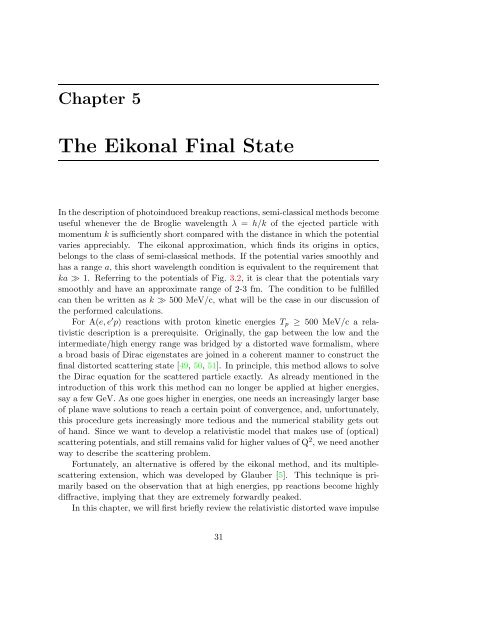Download Thesis in Pdf Format - Theoretical Nuclear Physics and ...
Download Thesis in Pdf Format - Theoretical Nuclear Physics and ...
Download Thesis in Pdf Format - Theoretical Nuclear Physics and ...
Create successful ePaper yourself
Turn your PDF publications into a flip-book with our unique Google optimized e-Paper software.
Chapter 5<br />
The Eikonal F<strong>in</strong>al State<br />
In the description of photo<strong>in</strong>duced breakup reactions, semi-classical methods become<br />
useful whenever the de Broglie wavelength λ = h/k of the ejected particle with<br />
momentum k is sufficiently short compared with the distance <strong>in</strong> which the potential<br />
varies appreciably. The eikonal approximation, which f<strong>in</strong>ds its orig<strong>in</strong>s <strong>in</strong> optics,<br />
belongs to the class of semi-classical methods. If the potential varies smoothly <strong>and</strong><br />
has a range a, this short wavelength condition is equivalent to the requirement that<br />
ka ≫ 1. Referr<strong>in</strong>g to the potentials of Fig. 3.2, it is clear that the potentials vary<br />
smoothly <strong>and</strong> have an approximate range of 2-3 fm. The condition to be fulfilled<br />
can then be written as k ≫ 500 MeV/c, what will be the case <strong>in</strong> our discussion of<br />
the performed calculations.<br />
For A(e, e ′ p) reactions with proton k<strong>in</strong>etic energies T p ≥ 500 MeV/c a relativistic<br />
description is a prerequisite. Orig<strong>in</strong>ally, the gap between the low <strong>and</strong> the<br />
<strong>in</strong>termediate/high energy range was bridged by a distorted wave formalism, where<br />
a broad basis of Dirac eigenstates are jo<strong>in</strong>ed <strong>in</strong> a coherent manner to construct the<br />
f<strong>in</strong>al distorted scatter<strong>in</strong>g state [49, 50, 51]. In pr<strong>in</strong>ciple, this method allows to solve<br />
the Dirac equation for the scattered particle exactly. As already mentioned <strong>in</strong> the<br />
<strong>in</strong>troduction of this work this method can no longer be applied at higher energies,<br />
say a few GeV. As one goes higher <strong>in</strong> energies, one needs an <strong>in</strong>creas<strong>in</strong>gly larger base<br />
of plane wave solutions to reach a certa<strong>in</strong> po<strong>in</strong>t of convergence, <strong>and</strong>, unfortunately,<br />
this procedure gets <strong>in</strong>creas<strong>in</strong>gly more tedious <strong>and</strong> the numerical stability gets out<br />
of h<strong>and</strong>. S<strong>in</strong>ce we want to develop a relativistic model that makes use of (optical)<br />
scatter<strong>in</strong>g potentials, <strong>and</strong> still rema<strong>in</strong>s valid for higher values of Q 2 , we need another<br />
way to describe the scatter<strong>in</strong>g problem.<br />
Fortunately, an alternative is offered by the eikonal method, <strong>and</strong> its multiplescatter<strong>in</strong>g<br />
extension, which was developed by Glauber [5]. This technique is primarily<br />
based on the observation that at high energies, pp reactions become highly<br />
diffractive, imply<strong>in</strong>g that they are extremely forwardly peaked.<br />
In this chapter, we will first briefly review the relativistic distorted wave impulse<br />
31















